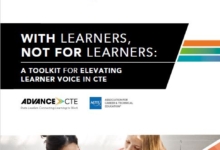In fall 2018, there were more than 5 million English Learners (ELs) in the United States, with about 1.9 million enrolled in grades 6-12.3 Although the federal definition applies only to elementary and secondary ELs, and postsecondary institutions are not required to report data on students’ language proficiency, many ELs are enrolled in higher education programs as well. In the 2018-2019 academic year, 520,417 secondary CTE participants were ELs.
Despite the considerable benefits of CTE for ELs, there remain significant barriers for these learners to fully access and succeed in CTE programs. State CTE leaders have considerable federal and state resources available to center curriculum, wraparound supports and data infrastructure to better understand and meet EL needs. In doing so, they make good on the promise to meet our shared vision for each learner to feel welcome in and have the means to succeed in CTE.
Improving Equity and Access to Quality CTE Programs for English Learners serves to enhance member knowledge of and support for learners who do not speak English as their first language. This brief outlines the key barriers for English learners to access and succeed in high-quality CTE programs, and provides five recommendations to leverage federal and state resources to lower and remove these barriers.
The recommendations include:
- Leverage federal legislation to ensure that secondary and postsecondary English Learners have access to high-quality CTE instruction;
- Embrace best practices and technological innovation to meet learners’ needs in curriculum and instruction;
- Invest in wraparound services and targeted support to remove barriers for English Learners and other special populations;
- Leverage data and center learner voice to identify and close equity gaps; and
- Provide professional development and technical assistance to educators, counselors and staff.






